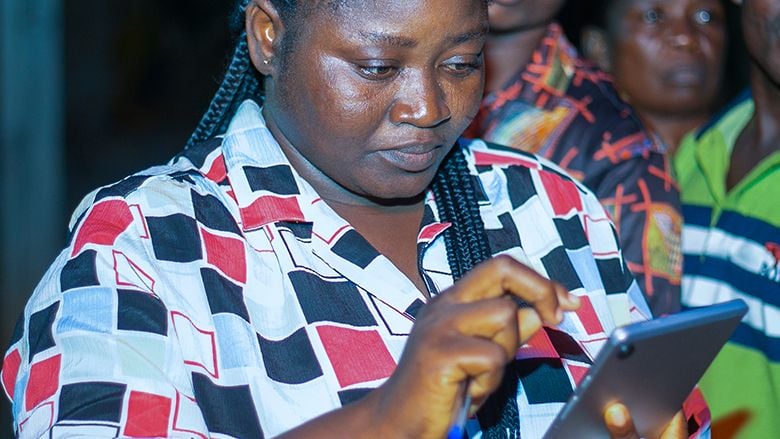Delivering free or subsidized agricultural inputs to smallholder farmers in Ghana has always been a challenge—especially during emergencies, when speed is of essence. The objective is straight forward: help smallholder farmers improve their yields, boost food security, and build resilience in times of crisis. Yet, inefficiencies, delays, and opacity have often hampered these efforts.
Great news, digital technology can help! With the support of the World Bank financed West Africa Food System Resilience Program (FSRP), Ghana’s Ministry of Food and Agriculture (MoFA) has introduced the Ghana Agriculture and Agribusiness Platform (GhAAP) an innovative digital solution that streamlines the distribution of free and subsidized agriculture inputs, ensuring faster, and more effective delivery, even during emergencies.
For a game-changer in emergency response, the timing proved fortuitous!
Shortly after GhAAP was introduced, Ghana faced multiple crises that required swift government intervention to support affected farmers with agriculture inputs.
In 2022, a macroeconomic crisis pushed nearly 850,000 Ghanaians into poverty and worsening food insecurity. Then, in 2023, a controlled spillage of the Akosombo and Kpong dams resulted in flooding in parts of the country causing widespread destruction, displacing thousands of people and damaging cropland. Again, in 2024, a long dry spell in parts of the country caused a decline in crop yields for major staples resulting in a rise in food prices.
Thanks to GhAAP, the Ministry of Food and Agriculture was able to respond rapidly to the crises, distributing essential inputs like fertilizers and seeds to affected smallholder farmers. Leveraging the Ghana Agriculture and Agribusiness Platform’s comprehensive digital database of over 1.2 million farmers nationwide, helped identify and locate eligible beneficiaries, saving valuable time and resources. Notably, the platform’s flexibility allowed even unregistered farmers to swiftly register and receive inputs simultaneously, highlighting the system’s flexibility and efficiency.
 Registering farmers and tracing input distribution with the Ghana card on the Ghana Agriculture and Agribusiness Platform. World Bank Ghana/Resolution.
Registering farmers and tracing input distribution with the Ghana card on the Ghana Agriculture and Agribusiness Platform. World Bank Ghana/Resolution.
A convergence of World Bank support
The development and implementation of the GhAAP and the Ministry’s emergency responses made possible through funding from the World Bank, under the FSRP-Ghana. In response to the macroeconomic crisis and flooding, $40 million worth of inputs were distributed to 155,000 smallholder farmers, including 20,000 flood-affected households. Furthermore, an additional $85 million was allocated to support 500,000 smallholder farmers affected by the prolonged dry spell, providing them with fertilizers and seeds.
No room for errors or shortchanging
All farmers who received inputs are registered on the GhAAP, with detailed records of the inputs they received stored in the database. The registration system is designed with robust checks to minimize errors and ensure transparency during input distribution. Each farmer is uniquely identified using their Ghana Card number, and their farm and residences are accurately georeferenced. Furthermore, officers capture and upload farmers’ photos during input distribution, preventing duplication and impersonation. This rigorous process guarantees that resources reach the intended beneficiaries, promoting accountability and fairness.
Here’s the best part!
Despite these improvements, one critical question remained: did the inputs reach the farmers as reported by the GhAAP? To validate the effectiveness of the GhAAP platform, the World Bank conducted an independent assessment through a phone survey of 1,520 farmers, randomly selected from the 155,000 beneficiaries. The results were overwhelmingly positive:
86% of farmers in the flood relief program and 74% in the macroeconomic crisis program confirmed receiving inputs. An impressive 98.6% of flood victims and 93.6% of macroeconomic crisis program beneficiaries received the expected NPK fertilizers. 90% of farmers obtained inputs free of charge, although 10% reported making some payments, highlighting the need for enhanced oversight.
These findings debunk the common notion that government-distributed inputs often fail to reach intended beneficiaries. The high confirmation rates demonstrate GhAAP’s effectiveness in ensuring fair and efficient distribution, while also identifying areas for improvement.
A model for future input distribution and verification
Ghana’s experience with GhAAP demonstrates the transformative power of digital solutions in emergency responses in agriculture. Building on this success, refining the platform, addressing minor discrepancies, and bolstering accountability measures will amplify its impact, making it a model for other countries seeking to modernize their agricultural input distribution systems.


